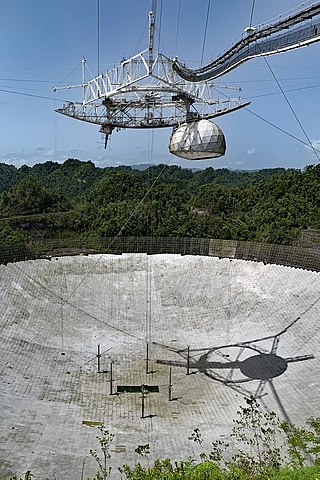
The Arecibo Observatory, also known as the National Astronomy and Ionosphere Center (NAIC) and formerly known as the Arecibo Ionosphere Observatory, is an observatory in Barrio Esperanza, Arecibo, Puerto Rico owned by the US National Science Foundation (NSF).

Steward Observatory is the research arm of the Department of Astronomy at the University of Arizona (UArizona). Its offices are located on the UArizona campus in Tucson, Arizona (US). Established in 1916, the first telescope and building were formally dedicated on April 23, 1923. It operates, or is a partner in telescopes at five mountain-top locations in Arizona, one in New Mexico, one in Hawaii, and one in Chile. It has provided instruments for three different space telescopes and numerous terrestrial ones. Steward has one of the few facilities in the world that can cast and figure the very large primary mirrors used in telescopes built in the early 21st century.

Vera Florence Cooper Rubin was an American astronomer who pioneered work on galaxy rotation rates. She uncovered the discrepancy between the predicted and observed angular motion of galaxies by studying galactic rotation curves. These results were later confirmed over subsequent decades. Her work on the galaxy rotation problem was cited by others as evidence for the existence of dark matter. The Vera C. Rubin Observatory in Chile is named in her honor.

The Hartung–Boothroyd Observatory (HBO) is located atop Mount Pleasant near Cornell University outside of Ithaca, New York (US). It is used mainly as a teaching facility for upper-level undergraduate astronomy classes. The observatory is named to recognize funding from M. John Hartung, a 1908 Cornell graduate and later chemical industrialist, and to honor Samuel L. Boothroyd, the founder of Cornell's Department of Astronomy. The facility was designed and directed from 1974 to 2012 by James R. Houck.

Clinton Banker Ford was an American investor, musician and amateur astronomer specializing in the observation of variable stars.

The Center for Astrophysics | Harvard & Smithsonian (CfA), previously known as the Harvard–Smithsonian Center for Astrophysics, is an astrophysics research institute jointly operated by the Harvard College Observatory and Smithsonian Astrophysical Observatory. Founded in 1973 and headquartered in Cambridge, Massachusetts, United States, the CfA leads a broad program of research in astronomy, astrophysics, Earth and space sciences, as well as science education. The CfA either leads or participates in the development and operations of more than fifteen ground- and space-based astronomical research observatories across the electromagnetic spectrum, including the forthcoming Giant Magellan Telescope (GMT) and the Chandra X-ray Observatory, one of NASA's Great Observatories.

The Indian Astronomical Observatory (IAO) is a high-altitude astronomy station located in Hanle, India and operated by the Indian Institute of Astrophysics. Situated in the Western Himalayas at an elevation of 4,500 meters (14,764 ft), the IAO is one of the world's highest located sites for optical, infrared and gamma-ray telescopes. It is currently the tenth-highest optical telescope in the world.

William Edwin Gordon was an electrical engineer, physicist and astronomer. He was referred to as the "father of the Arecibo Observatory".
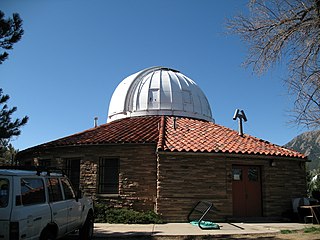
Sommers–Bausch Observatory is an astronomical observatory operated by the University of Colorado, Boulder on its main campus. The building was initially completed in 1953 and named after Elmer E. Sommers and Carl L. Bausch.
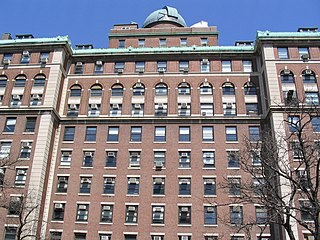
Rutherfurd Observatory is the astronomical facility maintained by Columbia University named after Lewis Morris Rutherfurd. Initially, Rutherfurd housed its telescopes and equipment in midtown Manhattan and later on the Stuyvesant Estate. When the Morningside campus was built, telescopes were kept in a "transit building" where the Interdisciplinary Science Building now stands. When Pupin Physics Laboratories were completed in 1927, the home of the observatory was moved to the top of the building. Below the Rutherfurd Observatory on the 14th floor was the site of Professor Wallace Eckert's Astronomical Laboratory, in which he constructed the first device to perform general scientific calculations automatically in 1933-34.

Fuertes Observatory is an astronomical observatory located on the North Campus of Cornell University in Ithaca, New York. The observatory was designed by L.P. Burnham, Cornell Professor of Architecture and completed in fall of 1917. It was originally used by the Civil Engineering Department as an instructional field office for navigation and surveying. Today, the observatory is primarily used for public outreach, welcoming over two thousand visitors per year with open houses on clear Friday nights.

The Heights Observatory is an Astronomical Observatory at The Heights School in Modbury Heights, Adelaide, South Australia.
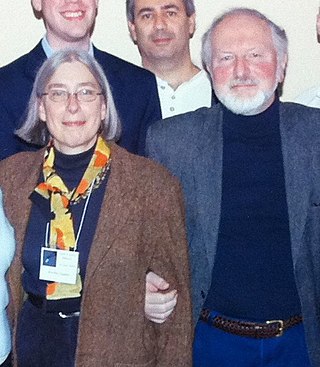
Martha Patricia Haynes is an American astronomer who specializes in radio astronomy and extragalactic astronomy. She is the distinguished professor of arts and sciences in astronomy at Cornell University. She has been on a number of high-level committees within the US and International Astronomical Community, including advisory committee for the Division of Engineering and Physical Sciences of the National Academies (2003–2008) and Astronomy and Astrophysics Decadal Review. She was a vice-president of the executive committee of the International Astronomical Union from 2006–2012, and was on the board of trustees of Associated Universities Inc from 1994 until 2016, serving two terms as board chair and one year as interim president.
The Canopus Hill Observatory, located approximately 12 km from Hobart in Tasmania, Australia, is an optical astronomy observatory belonging to the University of Tasmania (UTAS). Due to the high southern latitude, the Canopus Hill Observatory is able to observe and study the Magellanic Clouds. However, the observatory has closed down due to the "encroaching light pollution from the Hobart suburbs". According to the Astronomical Society, light pollution reduces the vision of the night sky, becoming a "major menace to amateur and professional astronomers alike".

Joseph Veverka is the James A. Weeks Professor of Physical Sciences, professor of Astronomy at Cornell University in Ithaca, New York. His research area is in planetary sciences, with a focus on physical studies of satellite surfaces and planetary rings. Veverka was the principal investigator on the NASA Discovery Program mission CONTOUR, a co-investigator of the Deep Impact space mission to Comet Tempel 1, and is the principal investigator on the NASA Discovery Mission of Opportunity, Stardust-NeXT. He is the recipient of the 2001 National Air and Space Museum Trophy and has the asteroid 2710 Veverka named after him.

Three College Observatory (TCO) is an astronomical observatory owned and operated by The University of North Carolina at Greensboro (UNCG), North Carolina Agricultural and Technical State University, and Guilford College (GC). Built in 1979, it is located 10 kilometers (6 mi) south of Graham, North Carolina (USA), in the Cane Creek Mountains. The observatory, designed by W. Edward Jenkins, was funded with a $250,000 grant, however, it would cost $1.5 million to replace it today. The observatory's primary instrument is a 32 in (81 cm) Ritchey-Chrétien reflecting telescope attached to an equatorial mount. It was built by Sigma Research and installed at TCO in 1981. TCO is used by UNCG for instruction and outreach. It continues to be the largest telescope in North Carolina and ones of the largest telescopes in the southeast.

Claudia Megan Urry is an American astrophysicist, who has served as the President of the American Astronomical Society, as chair of the Department of Physics at Yale University, and as part of the Hubble Space Telescope faculty. She is currently the Israel Munson Professor of Physics and Astronomy at Yale University and Director of the Yale Center for Astronomy and Astrophysics. Urry is notable not only for her contributions to astronomy and astrophysics, including work on black holes and multiwavelength surveys, but also for her work addressing sexism and sex equality in astronomy, science, and academia more generally.
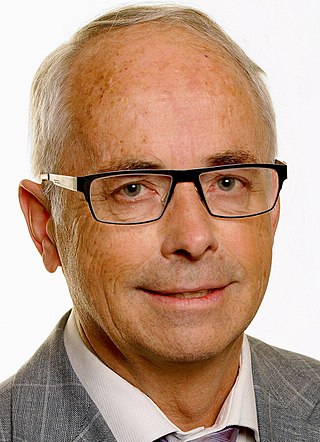
Arnold O. Benz is a professor emeritus at the Institute for Particle Physics and Astrophysics in the Physics Department of ETH Zurich.
Rachel Bean is a cosmologist, theoretical astrophysicist, professor of astronomy, and senior associate dean for math and science at the College of Arts and Sciences at Cornell University.

Yervant Terzian was an American astronomer. He was the Tisch Distinguished Professor Emeritus in Cornell University's Department of Astronomy, which he chaired between 1979 and 1999.


















